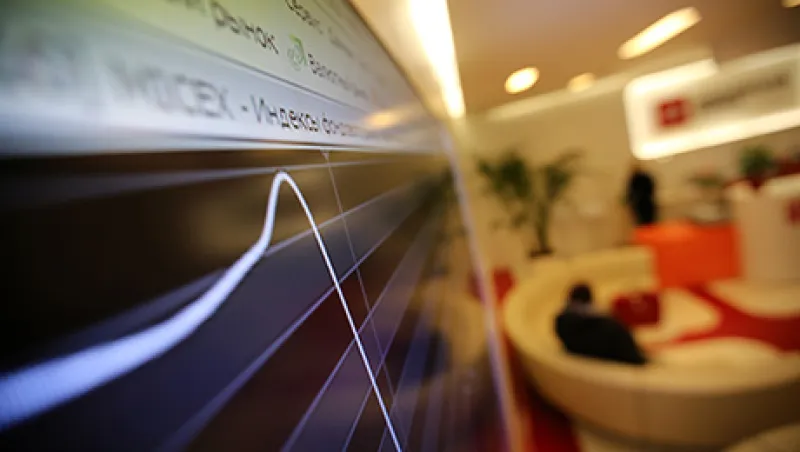Stocks on the Moscow Exchange (MOEX), Russia’s premier bourse, are not in high demand these days. Russia, the world’s eighth-largest economy, is stagnating, and its government stands accused of waging a proxy war in neighboring Ukraine. As measured by the iShares MSCI Emerging Markets ETF, Moscow’s benchmark Russian Trading System index is flat this year, compared with a 10 percent rise in global emerging markets overall.
But one Russian issuer just bucked the trend in impressive fashion: the exchange itself. The Central Bank of Russia (CBR) last week sold a nearly 12 percent stake in MOEX in a private placement worth some $500 million at 60 rubles, or some $1.75, per share. The issue was four times oversubscribed, according to an exchange statement.
Aside from signaling investor demand, MOEX stressed that the transaction brought its free float above 50 percent for the first time — bucking another trend in statist Russia, where other promised privatizations have been delayed for years. The CBR, which absorbed the former securities market authority last year, has promised to sell its remaining 18 percent share in MOEX by January 2016 to avoid owning a company it also regulates. “In moving to a majority free float, we want to set an example for our issuers,” MOEX chief financial officer Evgeny Fetisov tells Institutional Investor. Most listed Russian companies are still controlled by either the state or a founding oligarch. Two other Russian state banks own an additional 18.4 percent of MOEX, whereas the European Bank for Reconstruction and Development and China’s state-controlled Chengdong Investment Corp. hold 11.7 percent between them.
Investors’ appetite for MOEX shares is not surprising. MOEX stock has risen 18 percent since its initial public offering in February 2013, which followed the tortuous merger of two longtime rivals, the Moscow Interbank Currency Exchange and Russian Trading System. MOEX shares have shown a 21.4 percent return during the past 52 weeks.
“We made a series of promises to investors during the IPO, and we have kept them,” Fetisov says. Among those pledges were the creation of a central depository system, to standardize custody of Russian securities; a T+2 settlement regime that replaced the former prepayment requirement and gave buyers more flexibility; and a link to Euroclear Bank and Clearstream Banking that has made Russian government bonds available through those international central securities depositories. Clearstream, the clearing and settlement division of Deutsche Börse, based in Luxembourg and Frankfurt, opened trade in Russian equities July 7. According to Fetisov, MOEX is already gaining market share from a major foreign rival, the London Stock Exchange. The MOEX hosted 63 percent of transactions in dual-listed stocks last year, up from 53 percent in 2012.
Reform at the MOEX has hit some snags. The State Duma balked this spring at legislation that would have allowed electronic voting for shareholders and otherwise modernized corporate governance, causing Euroclear to delay a planned July 1 launch date for trading in Russian stocks. And the state was not just a seller in MOEX’s latest share placement. The Kremlin-backed Russian Direct Investment Fund bought “about half” of the shares on offer, fund chief executive Kirill Dmitriev told Institutional Investor. The RDIF already held 6.3 percent of MOEX’s stock, which it had acquired before the IPO in 2012.
But RDIF coinvested on both occasions with a roster of blue-chip managers from around the world. Dmitriev says the present group includes “a large number of people from the first round plus quite a few new names.” First-round partners included sovereign wealth funds like Abu Dhabi’s Mubadala Development Co. and such private equity mainstays as New York–headquartered BlackRock and the Cartesian Capital Group, also based in New York. “We believe in the fundamentals of the exchange and the high professionalism of the management,” says Dmitriev.
The MOEX got one more boost days before the private placement when Alexei Kudrin, who won global accolades as Russia’s finance minister from 2000 to 2011, took over as chairman of the exchange’s board. He replaced central bank deputy governor Sergey Shvetsov, a move considered to be another aspect of the CBR’s disentangling itself from the exchange. Kudrin restricted himself to restating the obvious in remarks to the press after assuming the MOEX chair June 26. “The Russian market needs more public offerings,” he noted. “The financial market has an incommensurably small role in investment.”
RDIF chief Dmitriev expressed optimism that the MOEX placement could get the ball rolling for other share issuers. “This transaction shows that it is possible to find investors,” he said. “We could see the IPO market open again in Russia in October, November, December.”
But with fighting still raging in eastern Ukraine and Russian President Vladimir Putin at loggerheads with Western leaders over Russia’s perceived role there, others are more pessimistic about the country’s marketability. Alexei Ulyukayev, minister of economic development, noted at a recent forum organized by MOEX that investors are “pausing” at the gates of Russia until peace comes to Ukraine.
Even during this pause, though, they showed confidence in the future of the country’s stock market. The MOEX placement was arranged by Goldman Sachs Group and JPMorgan Chase & Co., along with Russia’s Sberbank and VTB Capital.
Get more on emerging markets.






